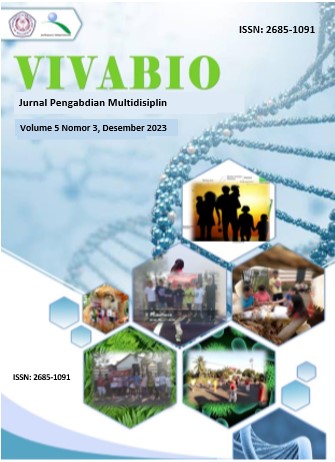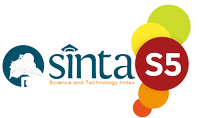Pemanfaatan ArcGIS Story Maps Sebagai Media Informasi dan Penyuluhan COVID-19 di Kota Palu
Utilization of ArcGIS Story Maps as a Media for Information and Counseling on COVID-19 in Palu City
DOI:
https://doi.org/10.35799/vivabio.v5i3.50069Abstract
The Corona Virus (COVID-19) pandemic continues to increase, the transmission, spread, and death rates are getting higher so the government implements large-scale social restrictions on people's activities in Indonesia. This high transmission can be caused by poor community behavior towards prevention programs that have been informed by the Government, therefore it is necessary to carry out dissemination and counseling related to COVID-19 to increase public knowledge in prevention and transmission to minimize the spread of COVID-19. Since April 2020, Covid-19 has been confirmed to have spread in 34 provinces in Indonesia. So that various regulations were issued to reduce the level of spread of COVID-19 starting from wearing masks, washing hands, keeping a distance, staying away from crowds and reducing mobility, large-scale social restrictions, imposing restrictions on community activities, vaccination programs in doses 1-3, and finally the health protocol for the transition period. Technological developments have encouraged the delivery of information to be more interactive. One of the uses of technology is the delivery of spatial information through ArcGIS Story Maps. ArcGIS Story maps are a way to visualize maps and nonspatial data in advanced web applications. The results of using Story maps are in the form of presenting information and counseling media in the form of interactive maps that contain an overview of COVID-19, case conditions, distribution levels based on urban villages, and how to handle them to related rules through the Story map feature
Keywords: COVID-19; Arcgis Online; Story Maps; Corona Virus
ABSTRAK
Pandemi Corona Virus (COVID-19) terus meningkat, angka penularan, penyebaran, dan kematian yang semakin tinggi sehingga pemerintah menerapkan pembatasan sosial berskala besar pada aktivitas masyarakat di Indonesia. Penularan yang tinggi ini bisa disebabkan oleh perilaku masyarakat yang kurang baik terhadap program pencegahan yang sudah di informasikan oleh Pemerintah, oleh sebab itu perlu dilakukannya penyebaran dan penyuluhan terkait COVID-19 untuk meningkatkan pengetahuan masyarakat dalam pencegahan dan penularan agar bisa meminimalisir penyebaran COVID-19. Sejak April 2020 Covid-19 telah terkonfirmasi menyebar di 34 provinsi di Indonesia. Sehingga terbitnya berbagai aturan guna menekan tingkat sebaran COVID-19 mulai dari menggunakan masker, mencuci tangan, menjaga jarak, menjauhi kerumunan dan mengurangi mobilitas, pembatasan sosial berskala besar, pemberlakuan pembatasan kegiatan masyarakat, program vaksinasi dosis 1-3, dan terakhir protocol kesehatan masa transisi. Perkembangan teknologi telah mendorong penyampaian informasi menjadi lebih interaktif. Salah satu pemanfaatan teknologi adalah penyampaian informasi spasial melalui ArcGIS Story Maps. ArcGIS Story maps merupakan cara untuk memvisualisasikan peta dan data nonspasial pada aplikasi web tingkat lanjut. Hasil penggunaan Story maps berupa penyajian informasi dan media penyuluhan dalam bentuk peta interaktif yang berisi tentang gambaran umum COVID-19, kondisi kasus, tingkat sebaran berdasarkan kelurahan dan cara penanganan hingga aturan terkait melalui fitur Story map.
References
Bowden, KK, Lin, GI, Reed, LI, Fox Tree, JE, & Walker, MA (2016). M2d: Monologue to dialogue generation for conversational story telling. In Interactive Storytelling: 9th International Conference on Interactive Digital Storytelling, ICIDS 2016, Los Angeles, CA, USA, November 15–18, 2016, Proceedings 9 (pp. 12-24). Springer International Publishing.
Ega, R., Armani, K., & Nursanti, S. (2021). Kampanye Gema (Gerakan Bersama) Melawan COVID-19 Oleh Dinas Kesehatan Kabupaten Karawang. 6(1).
Gössling, S., Scott, D., Hall, C. M., Gössling, S., Scott, D., & Pandemics, C. M. H. (2021). Pandemics , tourism and global change : a rapid assessment of COVID-19. Journal of Sustainable Tourism, 29(1), 1–20. https://doi.org/10.1080/09669582.2020.1758708.
Kirkby, J., Faulkner, J., & Perrin, J. (2014). 'Once there was a...': reclaiming storytelling in the middle years. Literacy Learning: The Middle Years , 22 (2).
Kelibay, I., Boinauw, I., Maipauw, NJ, & Sangadji, IM (2022). Education on Prevention of the Spread of COVID-19 in Klamalu Village, Mariat District, Sorong Regency, Indonesia. Journal of Indonesian Civil Society , 1 (3), 208-214. https://doi.org/10.59025/js.v1i3.31
Kementerian Kesehatan RI. 2020. Pedoman Pencegahan dan Pengendalian Coronavirus Disease COVID-19. Direktorat Jenderal Pencegahan dan Pengendalian Penyakit. Jakarta.
Marta, M., & Osso, P. (2015). Story Maps at school: teaching and learning stories with maps. J-READING Journal of research and didactics in Geography, 2(4), 61–68.
Sohn, M. (2016). Species Richness Maps and Esri Story Maps for the biodiversity of mangrove forests for the Mangrove Action Project (MAP). Issue: August.
Strachan, C. (2014). Teachers Perceptions of Esri Story Maps as Effective Teaching Tools, University of South Carolina.
Satuan Tugas Pengangan COVID-19. Peta Sebaran. Satuan Tugas Penangan COVID-19. Published 2021. Diakses Agustus, 2022. https://covid19.go.id/peta-sebaran.
World Health Organization. (2020). Global Surveillance for human infection with novel coronavirus (2019-nCoV): interim guidance, 31 January 2020 (No. WHO/2019-nCoV/SurveillanceGuidance/ 2020.3). World Health Organization. https://www.who.int/publications/i/item/globalsurveillance-for-human-infection-with-novelcoronavirus-(COVID-19).
World Health Organization (WHO). Novel Coronavirus (2019-nCoV): situation report; 2020.
Downloads
Published
How to Cite
Issue
Section
License
Copyright (c) 2023 Authors

This work is licensed under a Creative Commons Attribution-ShareAlike 4.0 International License.
ShareAlike — If you remix, transform, or build upon the material, you must distribute your contributions under the same license as the original.



